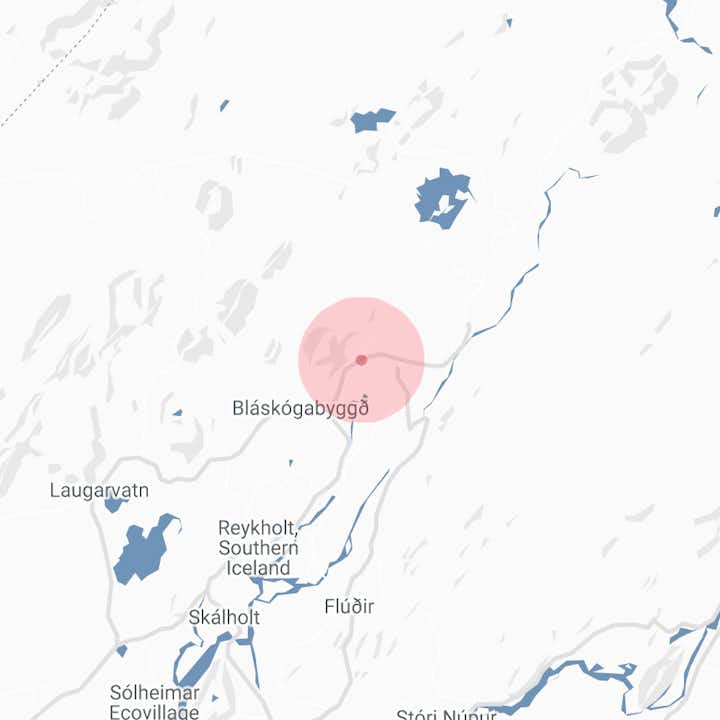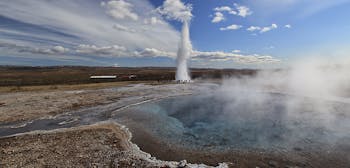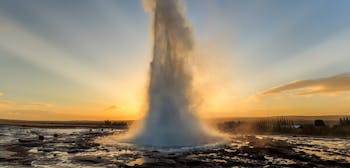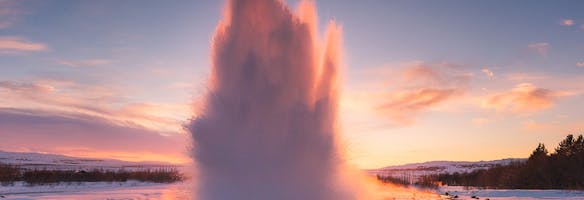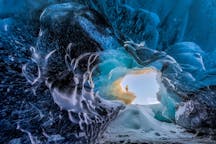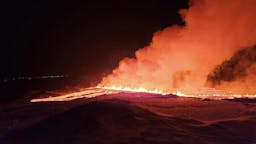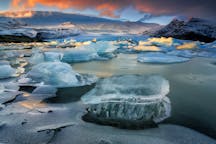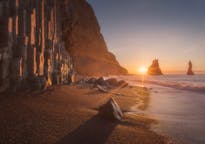Geysir Travel Guide
Geysir is a famous hot spring in the geothermal area of Haukadalur Valley, found in south-west Iceland.
Geysir is less than two hour's drive from the capital, making it easily accessible for many joining a Golden Circle day tour or those who rent a car. It is also visited on countless vacation packages and self-drive tours, such as this 6-Day Guided Winter Tour and this 7-Day Road Trip.
Making up just one of the attractions along the world-renowned Golden Circle sightseeing route, alongside Þingvellir National Park and the mighty Gullfoss waterfall, Geysir is most well-known for having lent its name to geysers all around the world.
FAQs about the Geysir geothermal area in Iceland
What is Geysir?
Geysir is a geothermal area located in southwestern Iceland that is famous for its hot springs and geysers.
What is the difference between a geyser and a hot spring?
A geyser is a hot spring that periodically erupts with water and steam, while a hot spring is a pool of hot water that does not erupt.
Is there an admission fee to visit Geysir?
No, there is no admission fee to visit Geysir, but there is a parking fee for cars.
How far is Geysir from Reykjavik?
Geysir is located about 120 kilometers (75 miles) from Reykjavik.
How do you get to Geysir?
You can drive to Geysir or take a Golden Circle tour from Reykjavik.
How often does Geysir erupt?
Geysir itself is no longer active, but the nearby Strokkur geyser erupts about every 6-10 minutes.
How high does Strokkur geyser erupt?
The height of Strokkur's eruption varies, but it usually reaches between 15 and 20 meters (49-65 feet).
Is it safe to approach the geysers in Geysir?
There are designated viewing areas around the geysers, and it is important to stay within those areas for safety reasons. The water in the geysers is extremely hot and can cause serious injury or death.
Can you swim in the hot springs in Geysir?
No, swimming is not allowed in the hot springs at Geysir for safety reasons. There are designated hot springs for swimming elsewhere in Iceland, such as the Blue Lagoon.
What is the temperature of the water in the geysers?
The temperature of the water in the geysers can reach up to 100 degrees Celsius (212 degrees Fahrenheit).
Can you drink the water in the geysers or hot springs in Geysir?
No, the water in the geysers and hot springs is not safe to drink due to its high mineral content and temperature.
What is the best time of year to visit Geysir?
Geysir is accessibly year-round, but summer (June-August) is the most popular time to visit due to milder weather and longer daylight hours.
What is the best time of day to visit Geysir?
The geysers are active all day, but crowds can be larger in the afternoon. Morning and evening can be quieter times to visit.
What is the temperature of the air in Geysir?
The temperature of the air in Geysir can vary widely depending on the season and weather conditions, but it is generally cool or cold due to the location in the Icelandic highlands.
Are there any other attractions in Geysir?
Yes, there are several other geothermal features in the area, including hot springs, mud pools, and fumaroles.
What other activities can you do in Geysir?
You can take a hike in the nearby Haukadalur valley, and visit the Geysir Center for lunch. We recommend the traditional Icelandic meat soup.
Are there any hotels or accommodations in Geysir?
Yes, there are several hotels, guesthouses, and campsites in the Geysir area. The closest one being Hotel geysir.
Geography of the Geysir geothermal area
Though Geysir itself is rarely active these days, Haukadalur Valley boasts a plethora of hot springs and geysers, including the powerful Strokkur, Smiður and Litli-Strokkur.
Strokkur is, arguably, the country’s most famous hot spring, shooting vast jets of boiling water from 20 metres (65 feet) up to 40 metres (130 feet) high. Don’t worry about missing this incredible spectacle of nature, as Strokkur erupts every five to ten minutes; just make sure to have your camera ready.
Geysir is much larger, but years can go by between eruptions here; it is currently in an inactive phase. When it does erupt, the water can shoot up in the air as high as 70 metres (230 feet).
Just a few minutes walk north of Geysir are a wealth of fumaroles emanating steam and gas into the cool Icelandic air. Aside from watching the hypnotic pillars of steam, you will also be able to observe the yellow sulphuric stains along the fumaroles themselves, a result of the earth’s minerals crystallising around the rock bed.
At the southern part of the valley, Þykkuhverir, you’ll find various bubbling mud pots. These spooky brown cauldrons are actually fumaroles that boil up through the loose ground; after a dry spell, these mud pools are likely to transform into a hardened fumarole.
Nearby Attractions
About two kilometres (one mile) from Geysir is a preserved natural pool called Kúalaug. It has room for three to five people at a time, but care should be taken, as the area around the pool is very delicate. The temperature is 39-43°C (102-109°F), depending on where you are positioned in the pool.
The water is slightly muddy, as the pool is built on soil, and the bottom is slippery due to algae, so caution is advised when relaxing here.
Haukadalur has also seen a rise in reforestation in recent times thanks to continued experiments and research in the area. Today, Haukadalsskógur is one of the largest forests in south Iceland, boasting accessible walking paths (also for wheelchair users), fascinating vegetation and The Tree Museum, built in the memory of forester Gunnar Freysteinsson.
History of Geysir
Haukadalur has been inhabited and used as a church site since the Age of Settlement. Given its historic value, it should be noted that scholar, Ari “The Wise“ Þorgilsson, grew up here; it was also where the first pastoral school in Iceland was built.
The current wooden church was last rebuilt in 1938 but its architectural style dates back to 1842, making it well worth a visit to see how Iceland looked before industrialisation.
For accommodation, Hotel Gullfoss is approximately 7 kilometre from the Geysir area, and closer still is Hotel Geysir on the other side of the road from the attraction, where you will also find a restaurant, café and a souvenir shop.
Attractions Nearby
Popular categories

Download Iceland’s biggest travel marketplace to your phone to manage your entire trip in one place
Scan this QR code with your phone camera and press the link that appears to add Iceland’s biggest travel marketplace into your pocket. Enter your phone number or email address to receive an SMS or email with the download link.
